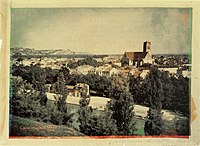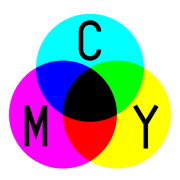Subtractive color
From Wikipedia, the free encyclopedia

A subtractive color model explains the mixing of paints, dyes, inks, and natural colorants to create a range of colors, where each such color is caused by the mixture absorbing some wavelengths of light and reflecting others. The color that an opaque object appears to have is based on what parts of the electromagnetic spectrum are reflected by it, or by what parts of the spectrum are not absorbed.
Subtractive color systems start with white light. Colored inks, paints or films placed between the viewer and the light source or reflective surface (such as white paper) subtract wavelengths from this white, and make a color.
Conversely, additive color systems start with no light (black). Light sources add wavelengths to make a color. In either an additive or a subtractive system, three primary colors are needed to match humans’ trichromatic color vision (caused by the three types of cone cells in the eye).
Contents |
[edit] CMYK printing process
In most color printing, the primary ink colors used are cyan, magenta, and yellow. Cyan is the complement of red, meaning that cyan acts like a filter that absorbs red. The amount of cyan applied to a paper will control how much red will show. Magenta is the complement of green, and yellow the complement of blue. Combinations of different amounts of the three inks can produce a wide range of colors; this is how artwork reproductions are mass-produced, though for various reasons a black ink is usually used as well. This mixture is called CMYK.
[edit] RYB
RYB is a historical set of subtractive primary colors. It is primarily used in art and art education, particularly painting. It predates modern scientific color theory.
RYB make up the primary color triad in a standard color wheel. The secondary colors VOG also make up another triad. Triads are formed by 3 equidistant colors on a particular color wheel.
The RYB primary colors became the foundation of 18th century theories of color vision as the fundamental sensory qualities blended in the perception of all physical colors and equally in the physical mixture of pigments or dyes. These theories were enhanced by 18th-century investigations of a variety of purely psychological color effects, in particular the contrast between "complementary" or opposing hues produced by color afterimages and in the contrasting shadows in colored light. These ideas and many personal color observations were summarized in two founding documents in color theory: the Theory of Colors (1810) by the German poet and government minister Johann Wolfgang von Goethe, and The Law of Simultaneous Color Contrast (1839) by the French industrial chemist Michel-Eugène Chevreul.
[edit] See also
[edit] References
- Berns, Roy S. (2000). Billmeyer and Saltzman's Principles of Color Technology, 3rd edition. Wiley, New York. ISBN 0-471-19459-X.
- Stroebel, Leslie, John Compton, Ira Current, and Richard Zakia (2000). Basic Photographic Materials and Processes, 2nd edition. Focal Press, Boston. ISBN 0-240-80405-8.
- Wyszecki, Günther and W. S. Stiles (1982). Colour Science Concept and Methods, Quantitative Data and Formulae. Wiley, New York. ISBN 0-471-02106-7.



